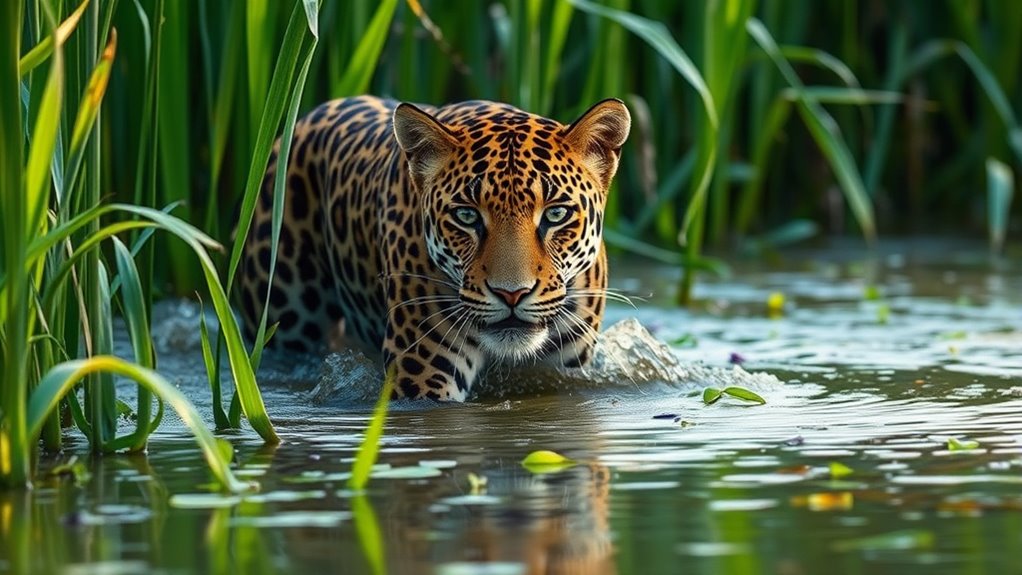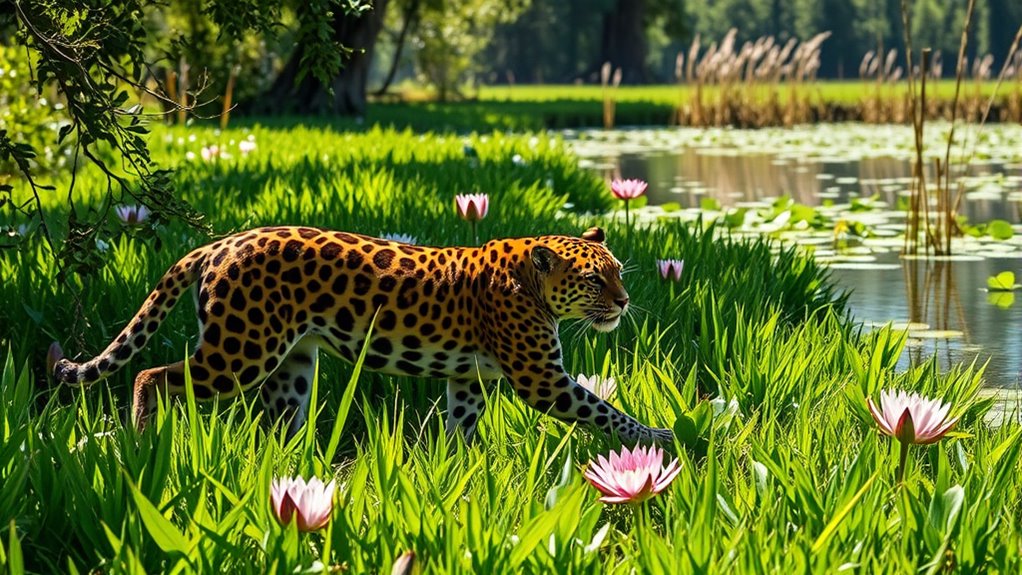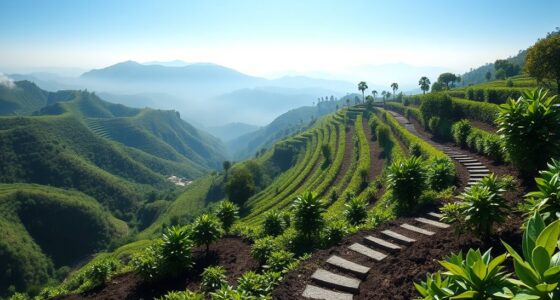The return of jaguars to Argentina’s Iberá Wetlands is a remarkable success story resulting from dedicated conservation efforts. These apex predators are reclaiming habitats they once lost, thanks to ecosystem restoration, anti-poaching laws, and community involvement. Their comeback indicates a healthier environment that benefits many species. Supporting sustainable practices and habitat protection helps this recovery continue. If you want to discover more about how this ecological revival is happening, there’s much more to explore.
Key Takeaways
- Jaguars are successfully reoccupying habitats in Argentina’s Iberá Wetlands after decades of near extinction.
- Conservation efforts, including habitat restoration and anti-poaching laws, have facilitated the jaguar’s comeback.
- The return indicates improved ecosystem health, with jaguars playing a vital role as apex predators.
- Community engagement and eco-tourism support ongoing habitat protection and jaguar conservation.
- Sustainable practices, like solar-powered camping, help preserve the wetlands and ensure long-term jaguar survival.

After years of absence, jaguars are making a remarkable return to Argentina’s wilderness, signaling a positive shift in the region’s ecological balance. This resurgence is a testament to successful efforts in ecosystem restoration and wildlife conservation that have taken place over the past decade. Once on the brink of local extinction, jaguars are gradually reclaiming their natural habitat in the Iberá Wetlands, a vast and protected area teeming with biodiversity. Your involvement in these conservation initiatives has helped create a safer environment for these majestic cats, allowing their populations to grow and thrive once more.
The Iberá Wetlands serve as a critical habitat, providing ample cover, prey, and water sources that jaguars need to survive. Conservationists and local communities have worked tirelessly to protect this fragile ecosystem from threats like deforestation, illegal hunting, and habitat fragmentation. By implementing strict anti-poaching laws and restoring native vegetation, they’ve created a landscape where jaguars can hunt, breed, and establish territories. Your support—whether through donations, volunteer work, or spreading awareness—contributes directly to these ongoing efforts, guaranteeing the jaguar’s comeback is sustained and expanded.
As jaguars return, they play a vital role in maintaining the health of the ecosystem. They act as apex predators, controlling populations of herbivores and preventing overgrazing that could damage the wetland’s delicate balance. Their presence indicates a healthy, resilient environment, which benefits countless other species, from birds to aquatic life. This ecological restoration isn’t just about saving one species; it’s about revitalizing the entire habitat and securing a future where biodiversity can flourish. Your participation in wildlife conservation efforts helps reinforce these positive changes, fostering a sustainable environment for generations to come.
The return of jaguars also highlights the importance of ongoing habitat protection and community engagement. Local residents now see the value of maintaining a healthy ecosystem, not only for the wildlife but also for eco-tourism and local livelihoods. Education programs have been essential in reducing human-wildlife conflict and promoting coexistence. By supporting these initiatives, you’re helping to guarantee that jaguars continue to roam freely in their natural habitat, symbolizing hope for ecological recovery. The successful comeback underscores that with dedicated conservation and ecosystem restoration, even the most endangered species can find a way back into their rightful place in the wild. Additionally, the use of solar panels for camping can help reduce pollution and habitat disturbance in remote areas like the Iberá Wetlands, supporting sustainable conservation efforts.
Frequently Asked Questions
How Do Jaguars Impact Local Ecosystems in Iberá Wetlands?
You might wonder how jaguars impact local ecosystems in Iberá Wetlands. As top predators, they play a vital role in maintaining ecosystem balance by controlling prey populations. This predator-prey dynamic helps prevent overgrazing and supports biodiversity. When jaguars thrive, they guarantee healthy, resilient habitats. Their presence influences other species, promoting a balanced, functioning ecosystem that benefits both wildlife and the overall environment.
What Are the Main Threats to Jaguars in Argentina Today?
You should know that jaguars face significant threats, with habitat fragmentation reducing their range by over 50% in some areas. Poaching remains a major danger, often driven by illegal wildlife trade. These threats compromise their survival, making it essential to protect remaining habitats and enforce anti-poaching laws. If you want to help, supporting conservation efforts can make a real difference for jaguars and their ecosystems.
How Do Conservation Efforts Involve Local Communities?
You play a crucial role in conservation efforts by engaging in community participation and promoting sustainable practices. Local communities are involved in protecting jaguars through education, monitoring, and habitat preservation projects. Your participation helps reduce human-wildlife conflict and guarantees that conservation efforts benefit both people and jaguars. By working together, you contribute to a healthier ecosystem, supporting jaguar recovery and fostering a sense of shared responsibility for the wetlands’ future.
What Is the Genetic Diversity of Jaguars in Iberá?
You might think jaguars are common, but their genetic variation in Iberá is surprisingly limited, which affects their population resilience. This low genetic diversity makes it harder for them to adapt to environmental changes or disease. Ironically, conservation efforts aim to boost their numbers, but without genetic variation, these jaguars might struggle to thrive long-term. Understanding their genetic health is critical for ensuring their survival in this fragile ecosystem.
How Can Tourists Support Jaguar Conservation Initiatives?
You can support jaguar conservation initiatives by choosing eco tourism benefits and practicing responsible travel. When you visit areas like Iberá Wetlands, opt for eco-friendly tours that prioritize wildlife protection. Respect local guidelines, avoid disturbing jaguars, and participate in conservation programs. Your responsible travel helps raise awareness and funds for protecting jaguars, ensuring their survival for future generations. Every mindful action you take makes a difference in safeguarding these incredible animals.
Conclusion
As you witness the gentle reawakening of jaguars in Argentina’s Iberá Wetlands, you feel a quiet hope bloom within. This graceful return hints at nature’s resilience, whispering that even in delicate balance, life finds a way. With every pawprint, the wetlands weave a story of renewal and harmony. You’re reminded that, like these majestic creatures, our shared future depends on nurturing the fragile beauty of the wild.










